Zuo-Guang. Ye Advanced Dielectric Piezoelectric and Ferroelectric Materials: Synthesis, Characterisation and Applications
Подождите немного. Документ загружается.

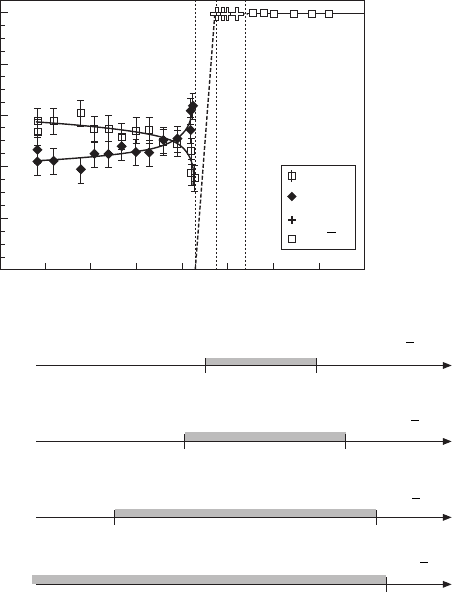
Handbook of dielectric, piezoelectric and ferroelectric materials420
observations agree, in particular the extensive observation of phase mixing
in this system as well as in others is in opposition with prediction of second-
order phase transition, also the possibility of triclinic phase was not observed.
It should also be mentioned that no direct transitions Pm → Pm3m or Cm →
Pm3m have been observed in any system. Also the question of multiple
points should be examined more in detail in further studies: for instance to
answer the question of how the cubic–tetra–rhombo–monoclinic regions are
connected.
14.4.2 From local polar order to long-range order:
monoclinic phase as adaptive phase
In Section 14.3.3, it has been proposed from diffuse scattering experiments
that the elastic accommodation between the CORs and the PNRs is realised
via a monoclinic short-ranged zone, which is also in agreement with the
% phase
100
80
60
40
20
0
X
= 0.415
I II III IV
Cm
Pm
P4mm
Pm3m
0 100 200 300 400 500 600 700 800
T
(K)
x
= 0.43
x
= 0.45
x
= 0.50
x
= 0.55
Pm+P4mm
Pm+P4mm
Pm+P4mm
P4mm
P4mm
P4mm
P4mm
490 K
550 K
465 K 565 K
420 K
585 K
590 K
Pm3m
Pm3m
Pm3m
Pm3m
T
(K)
T
(K)
T
(K)
T
(K)
14.20
Temperature evolution of the phase coexistence for some PSN–
PT compounds.
WPNL2204
From the structure of relaxors to the structure of MPB 421
structural data described in Section 14.3.1. Thus, on the mesoscale (i.e. few
nanometres) the monoclinic order may be considered as an adaptive phase
and serves as a ‘bridge’ between the CORs and the host-matrix. This local
and embedded monoclinic phase previously reported on relaxor-based systems
has also been observed by TEM on the non-relaxor PZT system (Glazer
et al., 2004) and in PMN–PT35% (Wang et al., 2006).
The progressive ‘growing’ of monoclinic phase when doping by Ti in
PMN–PT, PSN–PT or PZN–PT can be easily detected in diffraction experiments
through the observation of continuous widening of H00 peaks (which are
single in the rhombohedral patterns). In fact as already pointed-out, local
monoclinic order is detected even in the pure compounds, except that the
correlation length of the associated local polarisation appears to be higher in
PZN than in PMN, whereas weak Ti doping is needed in PSN to observe
such widening.
The notion of an adaptive phase first developed for martensitic
transformation was proposed by Khachaturyan et al. (1991) and Jin et al.
(2003) to explain the transformation pathway through the monoclinic phase
and associated features such as the tweed-like domain patterns observed in
MPB systems. The adaptive phase is issued from martensitic-like phase
transitions and is based on stress-accommodating twinned domains in a
similar way to the mesoscale structure proposed through the investigation of
the anisotropic diffuse scattering.
Some authors have also proposed that the different monoclinic phases of
MPB systems are in fact nothing other than tetragonal or rhombohedral
twinned nanodomains. A long time ago, such an idea was successfully used
in the field of incommensurate and quasicrystal systems, leading to debates
about the real existence of (for instance) five-fold (pentagonal) symmetries
or nano-twinning of six-fold twins. It appears in the end that both types of
system exist, i.e. ‘true’ incommensurate or quasicrystal systems and ‘ersatz’
nanotwinned commensurate or crystal. Perhaps the same situation will be
disclosed in the field of MPB. This is left for further studies.
14.4.3 Modelling of MPB phase diagrams
The origin of the term ‘morphotropic phase boundary’ is related to the
experimental observation of optimal properties in a restricted range of
concentration where two phases, rhombohedral and tetragonal, were supposed
to coexist. From this point of view the existence of monoclinic structures
appeared as a simpler way to rotate the polarisation; however, the discovery
that several monoclinic phases can exist and moreover coexist, also with the
rhombohedral or tetragonal phase involved, showed that the reality is in fact
rather complex. From a simplistic thermodynamic point of view the coexistence
of three phases is possible only at a definite and unique composition at
WPNL2204
Handbook of dielectric, piezoelectric and ferroelectric materials422
which an abrupt change of structure is supposed to happen when the
composition is changed. As pointed out by Rossetti et al. (2006), the diagrams
shown on Figs. 14.16 to 14.18 with abrupt boundaries cannot be equilibrium
phase diagrams and their geometry, with or without consideration of an
adjacent low-temperature monoclinic phase, contradicts thermodynamics:
according to the Gibbs phase rule, the single-phase fields on the phase diagram
must be separated by two-phase regions rather than by line boundaries. A
low-order Landau expansion in the approximation of the theory of regular
solutions by these authors showed that the phase coexistences appear to be
an equilibration process implicated by the thermodynamic. These questions
have been discussed in detail in PSN–PT by Haumont (2004).
The success of the phenomenological theory based on Landau–Devonshire
development had proved very successful in the field of magnetic and structural
phase transitions, well before the discovery of the MPB phases. The problem
of higher complexity, such as incommensurate systems for instance, has
been explained within this theoretical framework. Therefore an interpretation
of the phase diagram of PZT based on a eighth-order development of free
energy by Vanderbilt and Cohen (2001) quickly followed the experimental
report by Noheda et al. (1999). Local-density approximation (LDA) calculation
by Fu and Cohen (2000) was published the same year. The different paths of
rotation between the different possible phases have been studied and
synthetically condensed in figures such as Fig. 14.15, eventually involving
possible triclinic phase if twelfth-order polynoms are taken into account.
The main results of these works have been very briefly discussed above.
In connection with the experimental studies of the structures of MPB
diagrams we would like also to report some works from Bellaiche and
coworkers based on effective Hamiltonian calculation which have clarified
the problem of chemical versus polar order as discussed in this paper. Initially
the first system studied using these techniques was PZT (Bellaiche et al.,
2000). The results on PSN–PT (Haumont et al., 2003, 2006a) were published
later. The progressive ‘growing’ of monoclinic phase when doping by Ti in
PMN–PT, PSNPT or PZN–PT can be easily detected in diffraction experiments
through the observation of continuous widening of H00 peaks (which are
single in the rhombohedral patterns) (Fig. 14.21). Interestingly the first
principles simulations for disordered PSN–PT were unable to mimic the
observed path: only the M
A
phase was observed in the simulations among all
possible monoclinic phases. Moreover, it happened that the width of the
MPB obtained in the simulation was much smaller than that measured. Since
the disorder is responsible for the introduction of strong random fields,
which modify the ground state, it seems obvious that a deviation from a
perfectly homogeneous and disordered state should be realised. Simulations
made for different ordered states (some of them unrealistic!) showed other
interesting results; in particular the appearance of the M
B
phase (Fig. 14.22).
WPNL2204
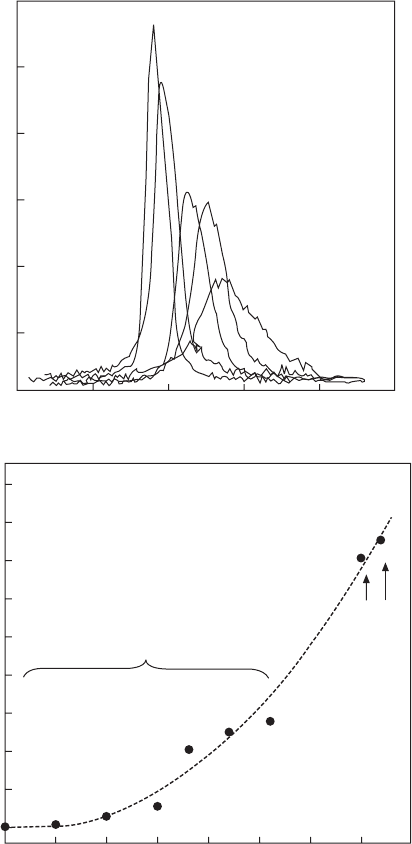
From the structure of relaxors to the structure of MPB 423
Another result from these simulations is that none of the theoretically
investigated ordered alloys has a rhombohedral ground state at compositions
with low Ti content: they all rather adopt a monoclinic phase at low temperature.
In fact, the simulations showed that the existence of chemically ordered
Intensity arb. units
300
250
200
150
100
50.0
x
= 0
x
= 0.10
x
= 0.18
x
= 0.26
x
= 0.35
39 39.5 40 40.5 41 41.5
2θ (°)
0.550
0.500
0.450
0.400
0.350
0.300
0.250
0.200
0.150
0.100
FWHM (°)
R3m
Cm
0.0 0.050 0.10 0.15 0.20 0.25 0.30 0.35 0.40
x
PT
14.21
X-ray rocking-curve of (200) peak in PSN–PT and associated
FWHM.
WPNL2204
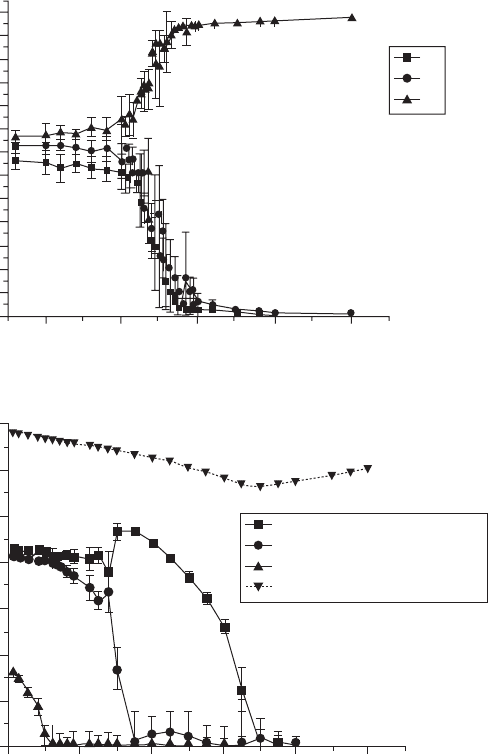
Handbook of dielectric, piezoelectric and ferroelectric materials424
clusters inside the disordered matrix is needed to widen the Ti-poor part of
the calculated MPB and thus to mimic the experimental observations. For
low Ti content this heterogeneous state leads to the appearance of a
rhombohedral phase.
These simulations explain the strong connection between chemical
composition at a local scale and polar states. It is probable that the same
P
x
P
y
P
z
Local polarisation magnitude
P
1
P
2
P
3
65
60
55
50
45
40
35
30
25
20
15
10
5
0
Spontaneous polarisation (µC/cm
2
)
R-phase
M
A
-phase
T-phase
0.40 0.41 0.42 0.42 0.44
Ti composition
(a)
Spontaneous polarisation (µC/cm
2
)
R-phase
M
C
- phase
T-phase
0 200 400 600 800 1000
Temperature (K)
(b)
70
60
50
40
30
20
10
0
C-phase
M
R
-phase
14.22
Spontaneous polarization as predicted by the Heff approach:
(a) versus composition in disordered PSN–PT at
T
= 50K; (b), versus
temperature in PSN–PT41 for ordered structure.
WPNL2204
From the structure of relaxors to the structure of MPB 425
scenario exists in other MPB systems as very similar polarisation path is
observed.
In fact these considerations arising from modelling allows the MPB systems
to be divided in two groups. The first group includes homogeneous systems
such as PZT in which no chemical order (CORs) has been observed and for
which the MPB is confined in a restricted concentration range, in direct
agreement with the results from simulations. Others are the relaxor-based
morphotropic systems such as PMN–PT characterised by the existence of
CORs and huge regions of concentration in which monoclinic order is detected.
A further example, among the BiBB′O
3
–PT systems (Suchomel and Davies,
2004) is BiScO
3
–PT (Eitel et al., 2004; Chaigneau et al., 2007) which illustrates
the ideas that homogeneous systems exhibit a confined MPB region, with a
unique monoclinic phase. However, in this distinction one has to take care
about the scale that is considered: indeed in PZT very short chemical order
(the first core shell around Zr or Ti) was considered in first-principles calculation
which clearly shows that the very local order may also strongly affect the
ground state (George et al., 2003).
14.4.4 From CORs to chemical inhomogeneity regions
(CIRs) in the MPB phase diagrams
It is known that doping PMN or PSN with PbTiO
3
results in the suppression
of the short-range chemical order (CORs) as is evidenced by the continuous
decrease of intensity and correlation length of the superstructure (SS) peaks
associated with cation chemical ordering. In PSN–PT (Fig. 14.23) with about
10% of titanium concentration, no more chemical ordering could be detected
but as SS factor peaks are also intrinsically diminished when Ti content is
increased, even in a perfectly ordered situation, Raman scattering experiments
are more accurate: indeed we were able to follow the local ordering of Sc/Nb
cations up to x = 0.16 concentration, a value above which no more ordering
is observed. However, we also observed the vanishing of dielectric relaxation
at concentrations far from x = 0.16 i.e. x = 0.485, just inside the MPB (Fig.
14.23) in contradiction to the mechanism of relaxation based on the interaction
of PNRs with CORs.
The same type of contradiction appears if one compares the concentration
evolution of the diffuse scattering in PMN–PT, associated with elastic
accommodation of PNRs with CORs which disappears between 0.25 and
0.30 (Fig. 14.24) whereas the dielectric relaxation is observed at least up to
x = 0.40, inside the MPB. These sets of observation seem to indicate that the
local ordering of Mg/Nb/Ti or Sc/Nb/Ti is not exactly the correct parameter
to consider for a global picture of relaxation and MPB in lead-based systems.
Disappearance of local ordering in PSN–PT well before the MPB
composition is reached is corroborated by the measurements of hysteresis
WPNL2204
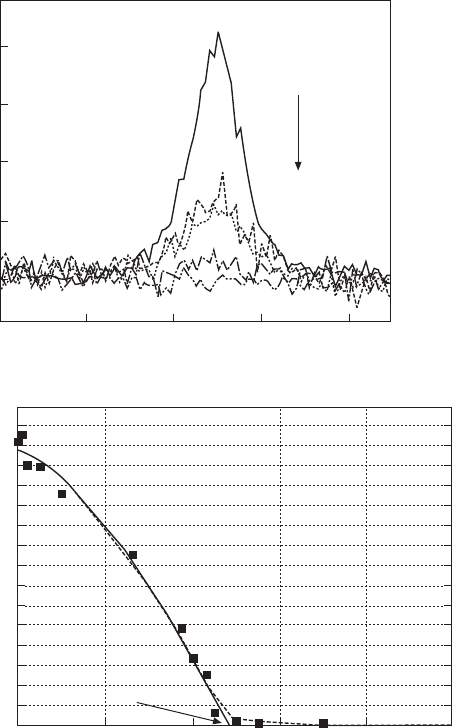
Handbook of dielectric, piezoelectric and ferroelectric materials426
loops of polarization in disordered and long-annealed samples of PSN–PT,
whereas for low concentration of titanium, difference in the P = F(E) evolution
between both types of samples is found, and above x = 0.16 no difference
exists. The same result is obtained when comparing the temperature evolution
of dielectric constant: above x = 0.16 the evolution is identical for the disordered
or long-annealed samples.
In fact, micro-Raman spectroscopy, which is very sensitive to the local
Sc/Nb/Ti arrangement of samples, shows a great variation of signal with the
Intensity arb. units
10
9
8
7
6
16.0 16.4 16.8 17.2 17.6
2θ(°)
(a)
x
= 0
x
= 0.01
x
= 0.02
x
= 0.05
x
= 0.10
∆
T
(K)
3.2
2.8
2.4
2.0
1.6
1.2
0.80
0.40
0.0
MPB
R
M
T
x
c
≈ 0.485
0 0.2 0.4 0.6 0.8 1
x
Ti
(b)
14.23
In PSN–PT, (a) vanishing of superstructure peaks associated to
CORs in PSN–PT; (b) concentration evolution of dielectric relaxation.
WPNL2204
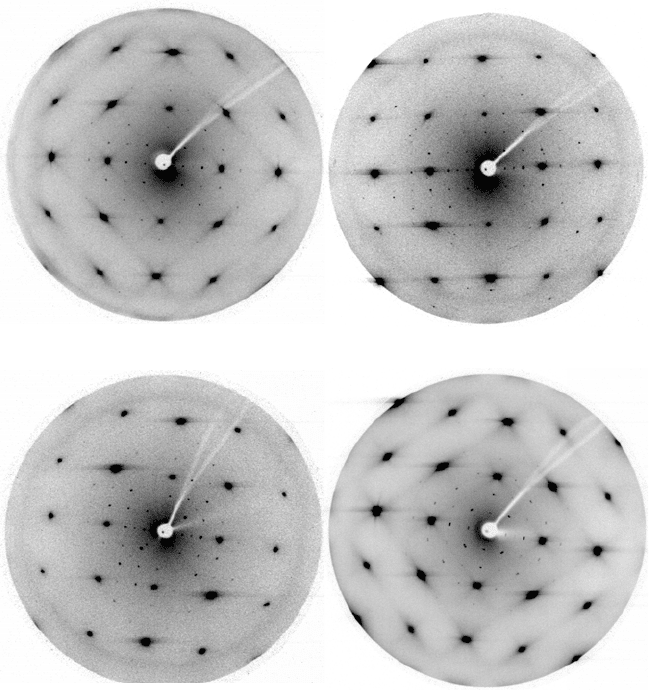
From the structure of relaxors to the structure of MPB 427
location of the beam on the surface of the ceramics, indicating a great
inhomogeneity of the Ti/Sc/Nb occupancy on the B-site of the perovskite. A
comprehensive Raman study of PSN–PT as a function of Ti content shows
that, on a local scale, heterogeneities exists up to 80% of PT (Haumont et al.,
2006a). The most striking feature in the Raman spectra (Fig. 14.25) arises
from the evolution of the relative intensity defined as I
1
/(I
1
+ I
2
), where I
1
and I
2
are intensities of band K (or G) and band J (or H), respectively. The
value of this ratio, continuously decreases and changes close to x = 0.80. In
the PMN–PT system, the similar band K disappears at about the same Ti
4+
content (Ohwa et al., 2001) and is a signature that a true tetragonal symmetry
is recovered above this concentration.
(b)
(d)
(a)
(c)
14.24
(
hk
0) sections of the room-temperature X-ray precession patterns
of the PMN–PT solid solutions with differerent lead titanate content.
WPNL2204
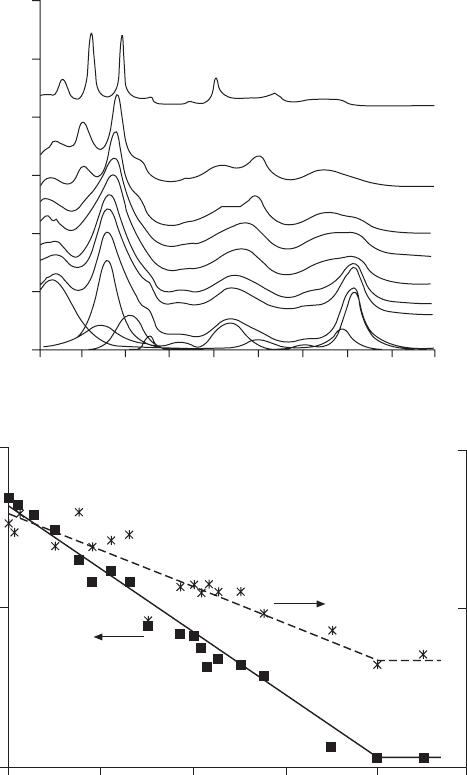
Handbook of dielectric, piezoelectric and ferroelectric materials428
Below x = 0.80 the Raman spectral evolution presented on Fig. 14.25 can
be described on the basis of the so-called two-mode behaviour which was
also proposed for the PMN–PT system (Chaabane et al., 2004). In this two-
mode scenario the vibration modes associated with band J and band K do not
Intensity (arb. units)
3
2.5
2
1.5
1
0.5
0
A
I
(1LO), E(2TO)
E(2TO, 2LO), B
I
A
I
(2TO)
B(2LO)
E(3TO)
A
I
(3LO)
F(4LO)
A
C
B
D
E
F
G
H
I
J
K
100 200 300 400 500 600 700 800 900 1000
Wavenumber (cm
–1
)
(a)
x
= 1
x
= 0.7
x
= 0.55
x
= 0.43
x
= 0.37
x
= 0.15
x
= 0.05
x
= 0
I
K
/(
I
K
+
I
J
)
1
0.5
0
0 0.20 0.40 0.60 0.80 1
x
PT
(b)
1
0.5
I
G
/(
I
G
+
I
H
)
14.25
(a) Room-temperature Raman spectra of PSN–PT powder
samples with various titanium concentration with a representative
deconvolution for pure PSN in insert. (b) Ti-dependence of the
relative intensity of band K (or G) and band J (or H).
WPNL2204
From the structure of relaxors to the structure of MPB 429
couple, that involves the existence of local phase segregation. The origin of
those bands should be due to alternation of zones richer in one constituent
than the other, with band J being associated with a very local segregation of
Ti-rich regions whereas band K corresponding to Mg/Nb-rich ones. These
local chemical orders would occur on the scale of a couple of unit cells
making them difficult to be detected by diffraction probes. In the PSN–PT
system, the same situation was also considered. Further complexity arises
from the fact that band J is detected also in pure PSN, meaning that this band
cannot be explained only on the basis of Ti-rich regions but should also be
associated with the CORs.
These sets of experiments show that the structure of the CORs transforms
with PT doping, even if they are not more detectable above x ≈ 0.16 by
diffraction technique. Above this concentration it is better to call them chemical
inhomogeneity regions (CIRs) which continue to act as a nucleation centre
for PNRs.
Additional proofs were obtained by the comparison of the diffraction
pattern of a MPB sample of PSN–PT (x = 0.43) which revealed definite
changes, before and after long-term annealing, in particular in the phase
mixing ratio of monoclinic phase Pm and tetragonal P4mm phase (85% of
Pm phase in annealed sample, instead of 79%). A comparative Rietveld
analysis shows in addition changes in the monoclinic angle (90.20° after
annealing instead of 90.09°), and also in the magnitude of polarisation for
both phases (62 and 67µC/cm
2
after annealing instead of 55 and 57°µC/
cm
2
). These experiments clearly indicate the strong effect of a chemical
rearrangement onto the ground state in the MPB region.
14.5 Stability of the MPB phases under external and
internal fields
Up to now we have mainly discussed the concentration and temperature
structural evolution of relaxors and MPB compounds. However, many potential
applications of these materials arise from the strong effect of electric field on
properties. Moreover these applications often require the use of materials in
the form of ceramics or thin films. That is why the effects of size reduction,
external pressure, substrate-induced misfit, etc., have been recently considered.
The electric field and pressure evolution of diffuse scattering have been
briefly discussed in Section 14.3.3. The object of this section is to point out
some results related to the question of phase stability.
14.5.1 Electric field effects
Pioneering works reported investigations of the non-ergodic state of PMN
under an electric field. Indeed, when the electric field is applied along the
WPNL2204
